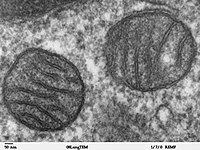
Photo from wikipedia
A novel, machine-learning approach to quantify cristae density and architecture in live-cell super-resolution imaging characterizes the ultrastructural parameters of individual mitochondria over time. Recent breakthroughs in live-cell imaging have enabled… Click to show full abstract
A novel, machine-learning approach to quantify cristae density and architecture in live-cell super-resolution imaging characterizes the ultrastructural parameters of individual mitochondria over time. Recent breakthroughs in live-cell imaging have enabled visualization of cristae, making it feasible to investigate the structure–function relationship of cristae in real time. However, quantifying live-cell images of cristae in an unbiased way remains challenging. Here, we present a novel, semi-automated approach to quantify cristae, using the machine-learning Trainable Weka Segmentation tool. Compared with standard techniques, our approach not only avoids the bias associated with manual thresholding but more efficiently segments cristae from Airyscan and structured illumination microscopy images. Using a cardiolipin-deficient cell line, as well as FCCP, we show that our approach is sufficiently sensitive to detect perturbations in cristae density, size, and shape. This approach, moreover, reveals that cristae are not uniformly distributed within the mitochondrion, and sites of mitochondrial fission are localized to areas of decreased cristae density. After a fusion event, individual cristae from the two mitochondria, at the site of fusion, merge into one object with distinct architectural values. Overall, our study shows that machine learning represents a compelling new strategy for quantifying cristae in living cells.
Journal Title: Life Science Alliance
Year Published: 2020
Link to full text (if available)
Share on Social Media: Sign Up to like & get
recommendations!